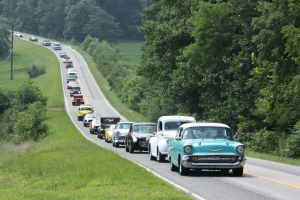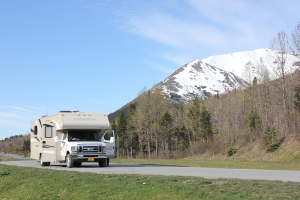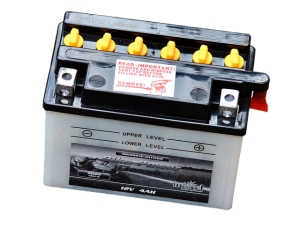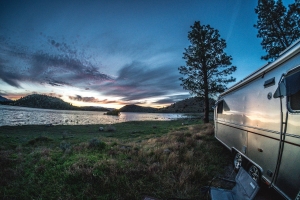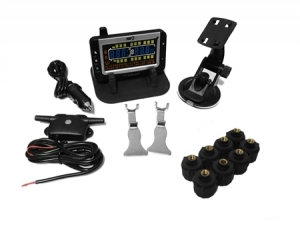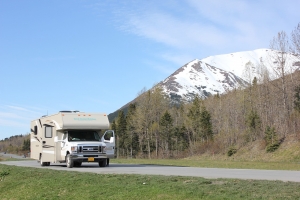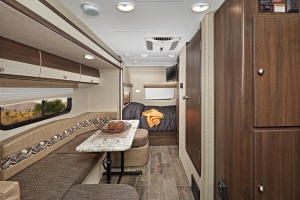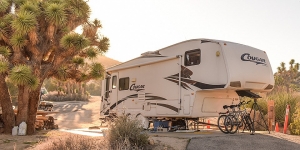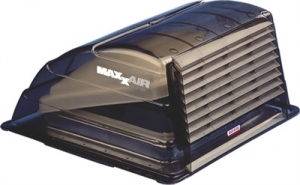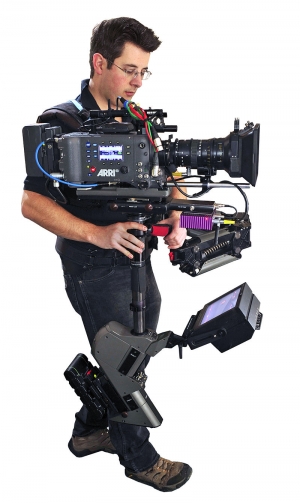Welcome to Crossing Creeks RV Resort & Spa in the heart of iconic Blairsville
Matt
Georgia Mountain Moonshine Cruiz-In, Georgia Mountain Fair Coming in July
There’s a lot to like about the 2019 Georgia Mountain Moonshine Cruiz-In, July 11-13 at the Georgia Mountain Fairgrounds, especially if the burble of a Detroit V8 is your idea of an unmatched musical treat. If country music is your preference—how do Pam Tillis, Neal McCoy, Ricky Skaggs and B.J. Thomas sound?— head back to the fairgrounds July 19-27 for the Georgia Mountain Fair.
The fairgrounds are in Hiawassee, a mere 18 miles from Crossing Creeks RV Resort & Spa, so you can stay at Crossing Creeks and venture over to the fairgrounds along Lake Chatuge for one or more days of the festivities.
Cruiz-In Has Moonshine Roots
Illegal moonshining is the inspiration for the Cruiz-In. When liquor dripped from stills tucked away among the mountains, men with hot cars and trunks full of illicit spirits did their best to outrun the law and make their deliveries. Those runs were the progenitors of stock car racing in the South. Who among those outlaws would have guessed that their lights-out midnight drives would generate a sport that’s become a national obsession?
The Cruiz-In will commemorate those runs with a much tamer parade of horsepower. The sounds of engines from cars entered in the show will reverberate off the hills of northeast Georgia as owners drive their candy-colored creations over 60 miles of rural roads.
Have a hot rod, street rod, rat rod, bike or other custom vehicle? You can have it pictured in color on an 11x17-inch poster with the Cruiz-In logo for $20 or on an 18x24-inch poster for $30. Posters can be ordered Friday and Saturday for delivery by mail.
And there’s a real still at work on the fairgrounds.
On July 13, three 1960s rock and pop bands will perform: the Grass Roots (“Midnight Confessions”), The Association (“Along Comes Mary”) and the Box Tops (“The Letter”).
For details see the Cruiz-In website or Facebook.
Georgia Mountain Fair
Here’s an old-fashioned country fair, mountain-style.
The Georgia Mountain Fair features everything you’d expect at a proper country celebration: arts and crafts, food, a cooking contest, a Miss Georgia Mountain Fair competition, a flower show, and, of course, lots of music.
In addition to local acts, including the Georgia Mountain Fair Band, there will be well-known chart toppers, all playing two shows: 2 and 8 p.m. Tillis will headline the musical entertainment on opening day, Friday, July 19. Neal McCoy will play Saturday, July 20. The Booth Brothers will add Gospel on Monday, July 22. Skaggs will be the feature act on Tuesday, July 23. The Spinners will take the stage Wednesday, July 24. Thomas will perform on Friday, July 26. T. Graham Brown will close out the fair on Saturday, July 27.
No Georgia fair is worth an over-ripe peach without a bluegrass day, which is Thursday, July 25, at the Georgia Mountain Fair, with Del McCoury, Mike Snider and Jeff Parker. Gospel music day is Sunday, July 21, with the McKameys, Primitives and Inspirations.
The fair offers a chance to learn a few things, too. You can visit the still, tour the old-time Pioneer Village, and take in “Old Ways Demonstrations,” where the experienced show how to make shakes (wood, not ice cream), squeeze cider, mill corn and perform other country skills.
Fair rides, which require a wristband for admission, run daily.
See the fair website for times and admission costs. Parking is free. Pets are not allowed.
Photo Credits: Facebook
Replacing RV Weather Strips
RV weather seals—also called gaskets or weather stripping—are as important in warm weather as in cold, and warm weather is a much better time to replace them if you do the work yourself. Warm weather keeps rubber gaskets more flexible, making them easier to work with.
You have three very easily understood reasons for renewing weather seals before summer. Seals that are in sound condition:
- Keep air-conditioned air in your RV and hot, humid air out.
- Prevent water leaks from heavy summer thunderstorms and road spray.
- Block out insects and other pests.
Weatherstripping is likely to deteriorate around entry doors, storage compartment doors, windows, operating roof vents and slide-outs.
Installation Types Differ
Some weather seals apply with glue, often (but now always) in the form of an adhesive backing on the seals themselves. The adhesive surface is exposed when you peel off a plastic or paper cover. These seals are common on entry doors.
Seals for sliders often are fastened with glue but require an application of liquid adhesive, since they typically don’t come with a pressure-sensitive backing. Some mount in tracks on the RV.
Other weather seals press into place. Many have a slotted surface that attaches to the edge of a window or compartment door, or to an upward-facing, leak-discouraging lip on the frame of a roof vent.
Finding a Proper Gasket
Seals may differ by make and model of RV, but buying more-expensive original equipment seals usually is not necessary. Several manufacturers offer aftermarket window, door and vent gaskets in a range of sizes, styles and prices. They typically have catalogs in RV stores or online charts to help find the proper fit. For instance, if you go to manufacturer Steele Rubber Products’ web page and click on slide-outs, you’ll find single and double bulb seals of varying heights and widths, seals with fins, seals with track mount, and seals with peel-and-stick adhesive, all shown in profile. Matching a seal profile usually turns up a match.
Other replacement gasket suppliers include CR Laurence, Bling-Flagship, Lightman, Minor Rubber, Perma-Fit, Trimlok and Zoro.
Simple Installation Steps
For a proper fit:
- Watch weather seal installation videos online before proceeding.
- Find and buy the appropriate seal, using in-store or online assistance.
- Take photos with your cell phone or digital camera of the old seal as it was properly installed, then intermittently during removal, so it’s easier to reverse the process during reinstallation.
- Read the instructions included with the new seal.
- Remove the stripping.
- Clean dirt, corrosion and glue residue from the RV surface. You may need a scraper and solvent. Take care not to damage paint and decals.
- Fit the new gasket, then install by using pressure-sensitive adhesive, applying adhesive or pushing a seal into place, depending on type. Remember: It’s easier to curve flexible rubber seals in warm weather than in cold weather. Working in the shade will prevent excessive heat from fiberglass or metal surfaces.
- Using a utility knife or shears, trim the seal to fit, then apply sealant to any small gaps that may result.
When buying slider seals, make sure they’re wide enough to overlap or cover the gap between the slide-out and the adjacent, stationary RV wall. That keeps out water, dust, pests and debris.
Lithium-Ion Batteries: Expensive, But More Efficient, Longer-Lasting
Lithium Ion batteries, or Li-ion, are a very real upgrade as deep-cycle batteries in your RV. Although more expensive, lithium ion offers a number of advantages over lead acid batteries.
Li-ion technology is young but not new. Li-ion batteries power many cell phones, laptops, power tools, consumer and commercial drones, and gasoline-electric hybrid vehicles.
Li-ion battery advantages:
- Weigh less.
- Are smaller compared with an equal-strength lead acid battery.
- Don’t vent, so they can be stored in more areas than traditional batteries.
- Maintain amperage during discharge.
- Last longer before needing replacement.
- Allow deeper discharges.
- Charge faster, making them more compatible with solar charging.
- Require no maintenance.
- Better resist damage from heat.
- May have smart management systems to prevent damage.
- Use a non-corrosive electrolyte.
Li-Ion battery disadvantages:
- Cost 3 to 5 times more than weaker lead acid battery.
- Can catch fire if damaged.
Price versus Performance
You will pay considerably more to purchase a lithium-ion battery, but over time, costs nearly even out.
Joe O’Connor, a senior application engineer at Mercedes-Benz Energy and author of the book “Off Grid Solar,” wrote on medium.com that the initial cost per kilowatt hour (kWh) with a lead acid battery is $131. For a Li-ion battery, it’s $530—a whopping 400 percent of the cheaper battery’s purchase cost.
But Li-ion batteries cycle 1,000 times for cheaper units to 4,000 times for higher-quality cells before they fall to an 80 percent state of health, compared with just 200 to 1,000 discharges for a lead acid battery. That means they should last years longer. By the time the Li-ion battery needs replacement, its total cost is just 11 percent more than its lead acid counterpart, O’Connor’s figures show.
More Convenient, More Powerful
There’s no question about the convenience of Li-ion compared with lead acid.
Li-ion batteries require no maintenance. There’s no need to top off water as there is in the lead acid battery—a task that’s difficult when batteries are hard to reach. Skip that chore with a lead acid battery, and battery life shortens dramatically.
Lead acid batteries also fail sooner if they are discharged beyond 50 percent. A Li-ion battery can be discharged 80 percent without damage. A Li-ion battery will supply power longer on each charge than a lead acid battery will.
When a Li-ion battery is discharging, there’s much more power on tap—5 times as much available power at constant current as a lead acid battery, according to O’Connor. The available power on lead acid batteries diminishes steadily as the batteries discharge, making them far less efficient in running an RV’s electronics.
Faster Recharging
The fast charging time of a lithium-ion battery is 2 to 4 hours. That’s a fraction of the time needed to recharge a lead acid battery, which is 8 to 16 hours, depending on the quality of the battery.
A Li-ion battery is just more willing to accept a new charge—about 99 percent efficient versus 85 percent for lead acid batteries. That makes Li-ion especially attractive for solar recharging. Solar panels, like Li-ion batteries, involve a high expenditure up front, but they save money over having to recharge with a generator, which needs gasoline or diesel fuel to run and oil for lubrication. With more efficient lithium-ion batteries, a smaller—and cheaper—solar array will be just as efficient as a larger array replenishing lead acid batteries.
The Future
Batteries for off-grid use will continue to shift toward lithium-ion, with a more pronounced move away from lead acid within just a few years. Expect Li-ion prices to drop as more manufacturers enter the market, increasing competition.
RVing Saves Vacationers Money, Study Shows
If you wanted to, you could stuff a lot of money into a camper. And if you’re wondering where the money would come from, it’s from the savings you experience by using a camper instead of other forms of vacation travel. Seriously. More American families are buying and using recreational vehicles for vacations, and the savings are a big reason. A major study shows that even when factoring in expenditures for the RV, including fuel and maintenance, vacations are cheaper when families go RV camping than when they use hotels and restaurants.
It all depends on the type of RV being purchased and used, but the study by CBRE Hotels Advisory Group, done in 2018, indicates savings can hit as much as 64 percent for a family of four hitting the road with a foldout camper, and more than 50 percent for two people. Even on the lower end of savings, researchers discovered, owners of a Type C motorhome could save 21 percent for a family of four and 8 percent for a couple.
Two groups, Go RVing and the Recreational Vehicle Industry Association, financed the study. Go RVing represents RV manufacturers, RV dealers and campgrounds that work to grow RV camping. The RVIA is a trade group representing RV manufacturers and parts makers.
Income-Appropriate Comparisons
CBRE, to avoid skewing the results, compared the use of different RV types to a range of alternatives. CBRE didn’t just compare vacationing in a folding camper trailer to flying and staying in a five-star hotel. The savings would have been obvious and unrealistic. Researchers did compare the costs of buying and using a luxurious Class A motorhome to flying first class, renting a premium car, staying in upscale hotels/resorts, and eating meals in restaurants.
Other modes of travel measured were:
- Folding camping trailer.
- Lightweight travel trailer.
- Compact motorhome (not specified, but probably Class B and/or pickup campers).
- Class C motorhome.
- Traveling in a personal car, staying at hotels/motels, and eating meals in restaurants.
- Traveling by airline, renting a car at the destination, staying at hotels/motels, and eating in restaurants.
- Traveling by personal car or airline, staying at a rental house/condominium, and eating most meals in the rental.
In addition to gauging the cost for two adults/two children, and two adults alone, CBRE researchers measured costs for vacations lasting three, seven and 14 days.
Calculated Savings
CBRE researchers left little to chance. Among the other factors they considered were such ownership costs as insurance, average ownership periods, and annual days of RV use, and even residual value.
Here’s how vacation cost savings added up for a family of four, by RV type:
- Folding camping trailer: 50-64%
- Lightweight travel trailer: 31-50%
- Compact motorhome: 31-50%
- Type C motorhome: 21-43%
- Type A motorhome – 41%
Here’s the vacation costs savings for a couple, by RV type:
- Folding camping trailer: 43-53%
- Lightweight travel trailer: 20-34%
- Compact motorhome: 20-34%
- Type C motorhome: 8-24%
- Type A motorhome: 19%
Fuel Price Fluctuations
You’re probably thinking, “Ah, but fuel prices were low, so the savings could evaporate quickly when prices rise—and they’re rising now.”
It would take an exponential increase in fuel prices to erase all the cost savings, research indicates. Fuel prices would have to soar to $13 a gallon for RVing to cost more than other vacation forms, according to the study.
When fuel prices rise considerably, RVers have ways of cutting expenses rather than eliminating their RVs, the RVIA says: They drive fewer miles with their RVs by vacationing closer to home and staying longer at one location. What they don’t do is abandon RVing, the RVIA says.
The research did not include figures on the return on investment of adding a vault to an RV interior. Maybe next time.
Adding TPMS to RV, Tow Vehicle Boosts Safety
If your tow vehicle, motorhome or trailer lacks a tire pressure monitoring system, commonly referred to by its initials, TPMS, the safety feature isn’t difficult to add. Adding TPMS is a good idea for RVers.
Losing a tire at speed is nasty business. The sudden loss of pressure—a blowout—can cause a vehicle to swerve or even to roll over. Tires that fail can also shred, and that can cause considerable damage to RV bodywork, especially aluminum bodies.
Losing a tire in the middle of nowhere on a long trip is no picnic, either. Getting a truck to come in and jack up any of your vehicles to change a tire is often far from instantaneous.
How TPMS Works
TPMS add-on systems basically have two parts—the sensors, which wirelessly send signals reflecting air pressure from each tire, and a wireless receiver, which gathers the information and displays it in any of several ways, depending on the system.
The monitor might display actual pressure in each tire, or it might simply show a message to check a tire, or all your tires. Individual readouts are the better choice.
Original equipment systems have monitors that are integrated into the dashboard. Aftermarket systems can’t do that, of course. They have monitors that attach to the instrument panel, on the surface or on the lower edge, or on a console surface. They’re reasonably attractive, so adding one won’t spoil your view of the instrument panel. Because they use their own batteries, there are no wires to run or connect.
Signals are sent wirelessly. Some sensors are mounted internally, which will cost more to mount because you’ll need a garage or RV center to do it. Then the tires and wheels will have to be balanced. The alternative is sensors that screw onto valve stems as replacements for valve stem caps. Manufacturers say there is no need to rebalance tires after replacing the valve caps with the lightweight sensors.
Some systems, in addition to monitoring tire pressure, monitor tire temperature and send readouts to the same monitor.
How Many Sensors?
TPMS kits come with different numbers of sensors and are priced accordingly. Four would cover your tow vehicle only, and not even that if it has a dually rear axle. Kits usually include a tool to help mount the valve-cap type sensor on the inner wheels.
It’s best to get a set that has enough sensors to read the pressure of each tire on your tow vehicle, your trailer and your spares. If your motorhome tows a dingy, get sensors for that vehicle, too. Look for models that offer, in addition to the sensors in the set, additional individual sensors or supplemental sets of two. That way you can get as many sensors as you need. You also can replace sensors that go bad. Regardless of where your sensors are, they’ll read out on the dash display you install as long as they’re compatible—the same brand and model.
Sensors are water resistant to help them hold up, a must if you’re towing a boat trailer. Screw-on sensors typically must be removed to add air to a tire, then screwed back on.
Lifespan
Sensors last about five years. After two years you should replace the watch-type flat batteries. Better to replace them than have them fail on a trip. Some monitors have rechargeable batteries, which don’t have to be replaced but can be recharged from the power port/lighter.
A nice thing about the screw-on type of TPMS sensors is that you can remove them while your RV is stored. That prolongs the life of the sensor and the batteries, if you remove them too.
Cost: Surprisingly Inexpensive
Costs vary by make, model and retailer. In general, a set of TPMS and temperature valve stem caps for eight wheels costs $380 to $600, including the display monitor. A set of 8 with internal mounts for wheels adds about $100. A color monitor might also elevate the price by $25 or so, but it’s useful for systems that measure both pressure and temperature.
Photo Credits: technorv.com
American Campers get Younger, More Ethnically Diverse
More Americans went camping last year, even with many traditional campers giving up on the lifestyle, probably due to advancing age. Campers are getting younger—maybe younger than ever—and coming from more diverse ethnic backgrounds.
The question: Will newer, younger campers embrace RVing as their parents and grandparents did? So far that appears to be happening.
Figures reported by Cairn Consulting Group in the 2018 North American Camping Report, the fourth such survey conducted for Kampgrounds of America, show that between 2014 and 2017, the number of U.S. households that camp a least once a year increased by more than 20 percent. Many campers, especially new and first-time ethnic minority campers, said they intended to camp more often last year, the report shows.
As of 2017, the number of U.S. households that camped at least once a year numbered 38,558,000, up nearly 3.9 percent from the year before. Between 2014 and 2017, the researchers found, the number of households that camped three or more times per year increased 64 percent, from 11 million to 18 million.
Bouncing Back from the Great Recession
The Great Recession in 2009 and 2010 had lingering effects on American camping, as it did on many segments of the economy that involved discretionary spending. Researchers at Statista.com found that the number of American campers increased about 3.1 percent between 2012 and 2017, but that the total number of campers was lower in 2017 than for each year between 2008 and 2011.
Increasingly, Americans who do camp are using their own RVs. The Recreational Vehicle Industry Association reports that manufacturers shipped about 483,700 RVs in 2018. That was a 4.1 percent decrease from 2017, but remember this: 2017 RV shipments were an all-time high, at about 504,600 units. The 2018 figures were still 12.3 percent higher than in 2016.
In 2016, the RVIA said, more than 9 million American households had an RV, the most ever. With sales increasing since then, and more first-time campers, that figure is likely higher in 2019. It’s dramatically improved over recession-level RV shipments, which totaled a mere 165,700 in 2009.
New Faces of Camping
The camping experience on all levels is spreading through the American population as never before, the 2018 North American Camping Report shows:
More young campers: Gen Xers, who make up 27 percent of the population, according to the Census, comprise 36 percent of campers. Millennials, a generation that has shown interest in the environment and physical activity, echo Gen Xers’ involvement. Although Millennials comprise 31 percent of the general population, they make up a larger share of campers—40 percent, the largest group by age. Baby Boomers, who made up 28 percent of campers in 2015, are down to 19 percent. Mature campers—that is, seniors—are down to 5 percent, less than half their share of the general population.
More minorities: More people from ethnic minorities are getting into camping. African Americans, once less enthusiastic about camping, are now participating in numbers more nearly proportionate to their makeup in the general population. Among new U.S. campers in 2017, Statista reports, 14 percent were African American, 17 percent were Latino and 17 percent were Asian/Pacific Islanders. Among all U.S. campers in 2017, whites made up 72 percent; African Americans, 8 percent; Latinos, 10 percent; and Asians/Pacific Islanders, 7 percent.
More children: More children are camping because two parent-age groups, Millennials and Gen Xers, together make up three-quarters of all U.S. campers, and many have children, Cairn researchers found. Just over half of all camping families have children who participate.
More RVs: Buyers 35 to 54 years old are the largest segment of RV owners, according to the 2011 University of Michigan study of RV consumers commissioned by the RV Industry Association. Leading-edge Millennials are fast approaching that age group. Historically, senior campers have been the strongest segment for RV ownership, an age group that baby Boomers are beginning to reach. That makes it likely RV sales will continue to rise.
Small RVs Gain New Popularity
Smaller RVs are becoming more popular as RV ownership hits new heights and attracts younger buyers.
With Millennials and Gen Xers now making up more than half of all RV owners, a trend toward small RVs make sense. Small RVs usually cost less, and younger buyers tend to have smaller bank accounts. Smaller RVs also are easier on the environment, which many progressive Millennials value.
Manufacturers Adapt
The Recreational Vehicle Industry Association explains that manufacturers have adapted to demands from new camping enthusiasts. “RV manufacturers are offering innovative new products that offer an optimal mix of size, amenities and price for today’s budget-conscious consumers,” RVIA reports. “Manufacturers are producing lightweight trailers and smaller, fuel-efficient motorhomes.”
RVs of all sizes are becoming more environmentally friendly, RVIA says. “Green technologies such as solar panels and energy-efficient components are appearing on an increasing number of RV models,” RVIA notes.
It doesn’t take a full-size V8 pickup to pull a small trailer. A compact pickup, a midsize SUV, crossover, and some sedans can pull many pop-ups, teardrops and compact trailers. The shift to small SUVs is undeniable—so much so that Ford is phasing out all cars but the Mustang sport coupe, with the rest of its vehicles to be SUVs and trucks of varying sizes.
Small RVs, because of design innovation, aren’t as cramped as they used to be.
Pop-Ups Look Like Home Runs
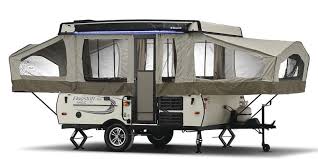 A pop-up trailer with tent sides and zippered windows, with a fiberglass roof that lifts up from the body, remains one of the cheapest tickets to trailer camping. For example, the Forest River 206LTD costs less than $7,500. It has central heat but not air, a roomy kitchen with under-counter refrigerator and adequate cabinetry, plus a clever carryout stove for outdoor cooking; foldout double and queen beds under canvas-covered bump-outs, plus a convertible dinette that sleeps two; stand-up headroom; and a 9-foot awning. The shower is on the exterior.
A pop-up trailer with tent sides and zippered windows, with a fiberglass roof that lifts up from the body, remains one of the cheapest tickets to trailer camping. For example, the Forest River 206LTD costs less than $7,500. It has central heat but not air, a roomy kitchen with under-counter refrigerator and adequate cabinetry, plus a clever carryout stove for outdoor cooking; foldout double and queen beds under canvas-covered bump-outs, plus a convertible dinette that sleeps two; stand-up headroom; and a 9-foot awning. The shower is on the exterior.
More protective are new “A” frame pop-ups with hard sides. In Forest River’s Flagstaff Hard Side, you see an awful lot of features and livability. At 2,600 pounds or less, it’s 21 feet long. There’s stand-up headroom; a heat pump; kitchen with 3-burner cooktop, sink, midsize refrigerator and cabinetry; sleeping capacity of four; a dining area; speakers inside and out; toilet; choice of inside or outside shower; and an awning.
Small Trailers Bring Real Comfort
Compact travel trailers have less floor space than a 35-footer, but they’re easier to tow, surprisingly spacious, and feature-rich, with standup headroom.
The Keystone Bullet Colt, for example, is 20 feet long and weighs about 3,000 pounds. It sleeps three or four in a queen bed and convertible dinette. The kitchen has a generously sized stainless steel fridge, two-burner cooktop, microwave and plenty of cabinet space. The bath is wet or has a curtained shower. Even a slideout is available. All Bullet Colts have pass-through storage. Buyers typically pay less than $20,000.
So Many Teardrops
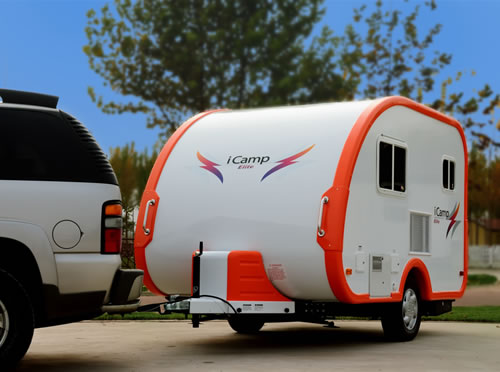 A staple of the 1930s and 1940s, teardrops never were quipped the way they are today. For campers accustomed to sleeping in tents, a teardrop is a nice step up. You know you’re still roughing it a bit when a teardrop has an exterior shower and a kitchen under a rear tailgate. The 14-foot iCamp Elite, however, is more refined, with a wet bath, full kitchen and dinette inside. It can sleep three. Some teardrops pop up for more headroom, then lower for more streamlined towing, and some have a manual slideout that expands space.
A staple of the 1930s and 1940s, teardrops never were quipped the way they are today. For campers accustomed to sleeping in tents, a teardrop is a nice step up. You know you’re still roughing it a bit when a teardrop has an exterior shower and a kitchen under a rear tailgate. The 14-foot iCamp Elite, however, is more refined, with a wet bath, full kitchen and dinette inside. It can sleep three. Some teardrops pop up for more headroom, then lower for more streamlined towing, and some have a manual slideout that expands space.
Class B Motorhomes
Built on extended gasoline- or diesel-powered work van chassis, Class B motorhomes offer just about everything a Class C offers, except the space. You’ll typically find dedicated beds, full kitchens, a TV, air-conditioning, sleeper dinettes, baths and awnings. Smart design, such as fold-up Murphy beds, expand living space.
A Class B isn’t cheap. A Winnebago Travato built on a Ram Promaster chassis sells for about $100,000 and up. Campers on a Mercedes four-wheel-drive platform may go as high as $250,000. A Class B is easy to drive—it would even get you to work in a pinch. It’s great for weekend getaways, including football games and tailgates.
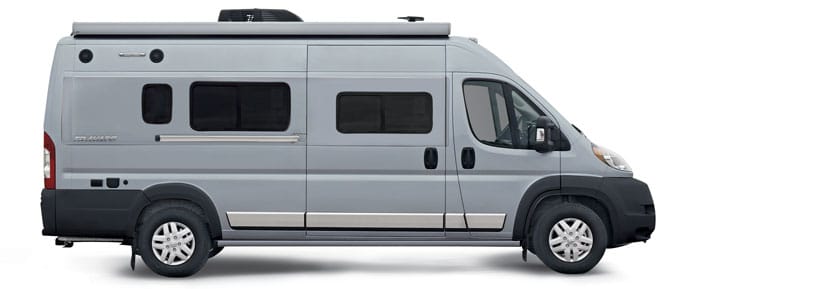
“RV owners overwhelmingly said in recent surveys that their RVs make it easier to take more frequent weekend getaways or mini-vacations that accommodate busy family schedules,” RVIA noted. Without the need to hitch a trailer, a Class B can be especially attractive to those campers.
Photo Credits: winnebagoind.com, urvusa.com, keystonerv.com, forestriverinc.com
National Parks and RVs
Can you take your RV into a national park and use it to camp?
Yes, you can. And no, you can’t.
Confused? You might be, because every national park and national monument has its own set of rules for RV camping. The rules differ because every park differs.
If you want to take your RV into a park, whether it’s a trailer or a motorhome, the National Park Service cautions that you must check out the rules for the specific park you plan to visit well in advance. You have to make a park campsite reservation well in advance, too, because space is limited—in more ways than one.
Some RVs Welcome at Some Parks
Here’s what the National Park Service says about RV camping at national parks and monuments: “RV and towed campers are more than welcome at national parks that can accommodate them.” Note the boldface italics, added for emphasis. The simple facts are that some parks can handle RVs, some parks can’t, and some can handle RVs only if they’re within size limitations or a certain type.
“RV and towed camper sites vary from park to park (i.e., pull-through campsites, back-in campsites), and there could be space issues with slide-outs,” the park service advises.
The need for reservations is quite simple. Campsites for RVs, where they are available, are few in number compared with demand.
Parking Your RV, Not Camping in It
At some national parks—there’s that phrase again—RVers can park if they don’t drive into the park. Some have spaces even if RVs can be driven into the park or monument but not camped. But not every park has RV parking spaces, which typically are where buses also are parked.
The park service makes finding RV parking rules for each park convenient online.
Even when spaces are available, they aren’t always adequate for the number of RV-driving visitors. The parks are perennially popular. At Little Bighorn Battlefield National Monument in Montana, for instance, the park service makes a creative suggestion to RV drivers who can’t find a space during the peak months of June and July—that they “drive out on the 5-mile driving tour road to the Reno-Benteen Battlefield and Entrenchment trail.”
Why? “Upon returning,” the service says, “there should be parking available.”
Simple enough.
Few Parks Have Hookups
RV hookups are rare at national parks. Where RV campsites are available, expect to boondock. After all, the parks are natural wonders. Preservation and RV hookups don’t exactly go hand-in-hand.
The website Tripsavvy.com does list three national parks with RV hookups:
- Yellowstone National Park, Fishing Bridge Campground only, 340 sites with 50-amp electrical, water, sewer.
- Grand Teton National Park, Colter Bay RV Park, 112 sites with water, sewer and electric; Headwaters Campground, an unspecified number of sites with 20- and 50-amp electric, sewer and water.
- Grand Canyon National Park, Trailer Village, sites with 30- and 50-amp electrical, water, sewer, cable; RVs up to 50 feet in length.
Private Alternatives
National parks are tourist magnets. That means there are many nearby RV facilities, some with full service, some without. Look online; it’s not hard to find a privately owned RV park to suit your needs.
We added the italics because that phrase is key to understanding whether or not you can.
Always check with the park you are visiting for size restrictions and the number of sites that can accommodate RVs and towed campers.
Photo Credits: National Park Service
Upgrade RV Roof Fans To Boost Ventilation
Many standard RV fans are modest performers. Fortunately fans come in standardized sizes, making it easy to upgrade.
Roof vents are 14 x 14 inches in the main living area and possibly in the bedroom, and probably 6 x 6 inches in the bathroom. Even vents without fans are likely to be 14 x 14.
There are quite a few reasons to replace a fan, even if it’s working properly:
- Increase airflow. Some fans, even the same size, can move more air. Airflow is measured in CFM—cubic feet per minute. Improving airflow helps to cool indoor temperatures. Boosting airflow in the bathroom reduces odors and prevents mold.
- Reduce noise. Some standard vent fans are noisy—doubly irritating if they’re not efficient.
- Add features. You can boost ease of use with a temperature sensor, rain sensor, remote control, multiple speeds, reversible blades or a rain hood.
- Protect a pet. Leaving a dog or cat in the RV is dangerous without certain fan features.
The best way to choose a fan upgrade is to answer some questions before buying:
What’s my budget?
Standard-grade roof vent/fan replacements cost about $60 to $110 for manual models. Installation would be extra, but many RV owners can install a fan themselves. They are powered by 12V wiring.
Adding features raises the price, but significant upgrades don’t cost much individually.
A model with remote controller, electric lift, built-in rain hood plus temperature sensor costs about $240 to $300. Aftermarket rain hoods range from $25 to $75. Prices vary by as much as 50 percent for the same model, so shop around, and remember that there’s never a need to pay list price.
What color do I want?
Inside, just about every fan is colored white or off-white. The most common color choices for lids are white and smoke. The smoke lids allow a bit of extra light to enter your RV. Some fans have clear blades, admitting even more light.
Rain hoods are available in a variety of colors, but most common are white, beige, grey and black.
Is remote control worthwhile?
Some see this as unnecessary, but remote control eliminates having to reach up to turn the unit on or off, get up from your seat to change a setting, or run wiring to a wall switch. Remote control is a boon for short RVers and those with disabilities. It will add maybe $35 to the price of an otherwise similar unit.
Do I want my fan to close automatically in the rain?
Most fans shouldn’t run in the rain, but after you open manual fans and turn them on, they keep running, even if it pours. Not only would rain enter the RV, but it also would damage the fan motor. Consider a model with a rain sensor, such as the Fantastic Fan 803350. It will turn off and close when rain hits. The one problem on any fan of this type is a rain sensor may stay wet, preventing the vent from reopening and the fan from coming back on—potentially deadly for pets.
Do I want to run my fan in the rain?
If you want to exhaust air in the rain, avoid the rain sensor but get a model with a rain hood, such as the Dometic EZ-Breeze Vent Fan, about $90. It allows use 24/7, rain or not. The MaxxFan Model 00-07000k, about $300, pops open under a built-in rain hood but closes almost flat and has a temperature sensor, plus remote control. An alternative is to find a fan you like and add an aftermarket rain hood, such as the Maxxair 933067, about $50. Less expensive hoods are available. Make sure the hood you buy won’t significantly reduce airflow. The more venting the hood has on its rear surface, the better.
Must I cool a pet while I’m away?
You have to care for your pet, even if you’re not physically in your RV. The right roof fan helps.
Just as important as leaving food and water is maintaining a safe temperature—ideally below 76F, and definitely below 80F. The best way to do that is to have a vent fan running. In addition to buying a model with a hood to allow use in the rain, or installing an aftermarket fan hood, get a fan with a temperature sensor, such as the Maxx Fan Model 00-07000k. In addition to shedding rain with its built-in hood, it cycles on and off to maintain the temperature, even if you’re not there.
Do I want a temperature sensor?
Even if you don’t have a pet, you might want this feature. The fan will automatically cycle on and off if the interior temperature reaches certain levels. That kind of comfort and convenience is nice to have for the few dollars a thermostat adds. It’s available on many fans in the $125-to-$150 range.
Do I want to bring air in as well as exhaust air?
During the spring or fall, or in the evening or morning, you may want to bring air in. This would be true especially if you have limited screened windows. To do so, you’ll need a vent/fan that can reverse its blades.
How much air does a fan move?
This might be especially useful to know in bathroom fans. You can’t easily increase the size of a bath fan to improve airflow, but you can increase airflow with a better motor and more efficient fan blades. Look at the CFM rating.
How noisy is the fan?
Unfortunately, many manufacturers don’t provide noise figures, measured in decibels (dB). If the product description doesn’t include the information, call the manufacturer or email to find out. There’s no guarantee, but a better-quality, more expensive motor and a higher number of blades typically increase air movement while lowering noise.
On the Set: Movie and TV Productions in Georgia
The “Walking Dead” TV show, all of Tyler Perry’s productions, the next Avengers movie and a reboot of the classic American TV soap opera “Dynasty” all have something in common: They are filmed either partly or entirely in Georgia.
You’d be amazed at how many productions are created in the Peach State—enough that you’d have a hard time missing the final product on your TV screen or in a movie theater. Since 2016, more feature films have been made in Georgia than in California, so move over, Hollywood.
Take a look at a list of scheduled releases filmed in Georgia. And that list grows continually.
Why Film in Georgia?
For one thing, the state encourages the production of TV shows and movies. It does so pretty much the same way other industries are encouraged all around the country: through tax incentives.
Film and Video producers can save money by producing in Georgia. They pay no sales and use tax. They get a 20 percent income tax credit on up to $500,000 in expenses, and another 10 percent if they use the Georgia Entertainment promotional logo onscreen toward the end of their film. Within their first decade, the claimed credits increased about 50 times the original claims in 2005. That means a lot of companies are producing here, and they’re spending considerable amounts of money in the state.
Where Filmmakers Work in Georgia
Georgia is attractive as a production destination because, quite simply, it has the looks—a great deal of diversity in its readymade scenery—and a temperate climate. Atlanta alone offers skyscrapers, historical buildings and a variety of neighborhood types for street scenes, from upscale to less than savory. (Just about any major city does.) There’s an industrial side, railroads, bridges, sports arenas, parks—you name it.
Nature didn’t short Georgia with interesting places. It has mountains, a coastline, a countryside, farms, rivers and whitewater. It also has a wealth of small towns, picturesque college campuses and some old cemeteries that are downright eerie.
Production centers in Atlanta, but there’s also a good deal of activity in Norcross, as well as in other locations.
Studios in Georgia
Turner Studios, part of TimeWarner, has been in Atlanta since its inception. It has produced both TV programs and movies in Atlanta. Perhaps its highest profile TV property is CNN, the 24-hour cable news network. Turner also owns truTV, TNT, Turner Cassic Movies, Cartoon Network, Adult Swim and other properties.
EUE/Screen Gems has renovated and expanded buildings at the Lakewood Fairgrounds in Atlanta under a 50-year lease with the city, signed in 2010. Added was a 37,500-square-foot soundstage. Feature films, TV shows and commercials are recorded at the facility.
Tyler Perry Studios was founded by the actor/writer/director in 2006 in Atlanta. Perry films all of his movies there, including those in the highly successful Madea comedy franchise. Part of the “Walking Dead” TV episodes are filmed there, too.
Marvel Studios, a spinoff of the famed comic books, also films in Georgia. Among its Georgia-shot films are “Avengers: Infinity War,” “Avengers: Endgame,” “Ant Man and the Wasp” and the megahit “Black Panther.”
Other filmmakers find Georgia just peachy, too. Academy Award-winning director Clint Eastwood, whose film-acting career took off when he acted in Italian and Spanish Westerns, has filmed several movies in Georgia. Among them are “Tully,” “American Sniper,” “Trouble with the Curve” and “The Mule.”
Seeing Where Movies Are Made
If you want to get closer to Georgia movie productions, you can actually take tours of locations where films and TV shows have been made.
For example, you can visit sites where the zombies have tread while making the wildly popular “Walking Dead” TV series. If you’re a fan of the show you’re bound to recognize some of the places. There are scads of other sites that have appeared on film and the small screen—the minor league ballpark from “42,” about Jackie Robinson; President Snow’s mansion from the “Hunger Games” films; and the Blue Ridge TreeHouse, built by The TreeHouse Guys for an upcoming series—and available for overnight stays.
You can also tour studios, just as visitors do in Hollywood, but with Southern hospitality thrown in. The link lists studio hours and contacts.
Want To Appear in a Movie?
If you’d like to actually be in a production—maybe as a passenger at an airport, a sporting event spectator, a body in a morgue, or a zombie—click here and we’ll tell you how to go about it.
Image Credits: Steadicam
